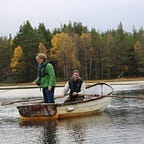How Five Creatives Capture Place with Unconventional Art
From eclectic globes and maps to unique teas and watches, these artists explore the world outside the typical atlas.
Illustration by Soeren Kunz
Many of us capture our surroundings by snapping a photo or, on a vacation, perhaps picking up a postcard or springing for a local artist’s painting of a street scene. These are all great ways to portray and preserve a place, but as these five artists prove, they’re certainly not the only options. Read on to discover the unique mediums these makers use to explore locations.
1. Political Canvas: Qiu Zhijie, “Map of the Theater of the World”
“All of us have a map in our heads of everything,” artist Qiu Zhijie once said. Qiu, who lives in Beijing, was born in 1969 in China’s Fujian Province, and has since applied his calligraphy to a number of mediums, including photography and film, to explore complex topics like self-actualization and China’s place in the world.
This map, created in 2017 and on view at New York City’s Guggenheim Museum, is both chronological and thematic. It looks geographical but actually charts a multitude of political and cultural movements within China and around the world since 1989. It’s a map of the mind that can be navigated just as accurately as a handmade globe.
2. Sphere Genius: Peter Bellerby, Bellerby & Co Globemakers
Peter Bellerby wanted to buy his father a globe for his 80th birthday in 2008. When none fit the bill, he decided to build one. But he ran a little late on the first order. “Dad eventually got it…in 2011,” Bellerby says.
Today, he and his London-based team handcraft globes using precise molds, cartography, calligraphy, and a hair-raising last step: applying the final panel. “You can ruin months of work in that moment,” he explains. When finished, the blank sphere suddenly becomes “something with much more meaning” — the world. The shock of that transformation doesn’t get old, Bellerby says. “The process constantly makes you think about the world, your place in it, and how fragile it all is.”
3. Panoramic Brew: Ruby Silvious, 363 Days of Tea
When painter Ruby Silvious, based in Coxsackie, New York, applies to artist residences around the world — in Greece, France, Spain, Italy, and Japan over the past several years — her pitch is always the same. “I propose that I will build a body of work painting on the used tea bag,” she says.
The discardability of her medium belies its power. The tiny scenes Silvious paints explode with color, texture, and detail, recalling the world through her eyes. In her book, 363 Days of Tea, subjects range from seaside panoramas to portraits to apparel (including what she’s dubbed “tea shirts”). But the most common inspiration for her work is the medium itself. When Silvious travels the world, she relies on local-brand tea bags but also uses any recyclable refuse: eggshells, paint chips, dried leaves. “I want to challenge the viewer to consider the art of the possible,” she says. “After your frittata tomorrow, don’t throw the package away. Throw some paint on it.”
4. Soundscape Architect: Gordon Hempton, “Global Sunrise: The Musical Sounds of Dawn”
“The earth is a solar-powered jukebox,” says Gordon Hempton. It’s something of a catchphrase for the acoustic engineer, who’s based in Washington state but travels the world recording rare natural sounds.
In his collection Global Sunrise, Hempton follows the music of the waking planet from the Amazon to Central America, the American West, Hawaii, the Australian Outback, Southeast Asia, and Africa, back to the howler monkeys and birds that welcomed the sun 24 hours earlier. “Sunrise has swept around the planet from the beginning of time,” Hempton says. “It’s an endless planetary tune that’s evolved with life itself.”
5. Local Time: Crispin Jones, Mr Jones Watches
London watchmaker Crispin Jones got his start in the early 2000s as a designer of intriguing artworks. One, a table with a slot for a question card, displayed the answer across the tabletop — but only if the user held the card in place as the slot got hotter to the touch.
His timepieces are similarly evocative — like the Time Traveller, which displays 16 time zones at once. Each of its hands are rendered as landmarks from that time zone; minutes are marked by a pigeon, the universal city dweller. “It’s pictorial, so you have that childhood sense of being transported,” says Jones. “You can visualize the sense of distance between these places. We’re all united on the watch’s face.”
About the author: Chris Wright is a freelance writer based in Los Angeles. He has written for Outside, Gear Patrol, and Wired. Follow him on Twitter.
